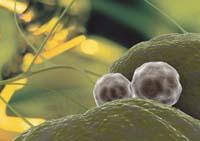Fever: heat against the disease

But, fever ? According to the ancient Greeks, the body had four humors: blood, phlegm, black humor and yellow humor. If the body generated in excess one of those four, the disease appeared. To restore the imbalance, the body responded through the fever: “it cooked” the excess of humor and, thus, the disease escaped from the body. Therefore, the fever was beneficial.
The idea of contributing to the fight against evil has been maintained almost to this day. However, sometimes doctors have shown that it can be dangerous, so they decide in each case whether they should undergo a fever reduction treatment. Yes, the definition of fever has changed radically.
Fever is the state that occurs when the temperature that establishes the thermoregulation center is higher than normal. The thermoregulation center is located in the cerebral hypothalamus, which is responsible for maintaining a stable body temperature.
Body temperature fluctuations

Only hot blood animals have this zone of regulation of body temperature. This is what sets them apart from those of cold blood. Its body temperature is posterior to that of the environment. Hot blood animals, regardless of their outside temperature, have the same body temperature.
In principle, variations occur at body temperature depending on whether it is a morning or a satin, age, etc. In women there are also small changes throughout the ovulation cycle, which allows women to know if it is a good time to get pregnant. But the changes are small, especially in relation to the increase in fever.
When there is fever, the temperature setting of the thermoregulation center can be between 3 and 4 degrees higher than normal. For the body it is as if it were in the first hypothermia, so there are reactions of body heating: increase of the heart rate, muscle contraction (chills)...
Along with it appear other symptoms such as headache, muscles and joints, sweating...The symptoms can vary depending on the person who has them and the fever. There are eleven diseases that can produce fever. It appears mainly in infections of viruses or bacteria, but also in inflammatory diseases and others.
Opening the door

As it is a complex mechanism, researchers have not yet clarified all aspects of fever and carry out numerous investigations. For example, they have recently discovered how fever helps white blood cells in the blood.
White blood cells or lymphocytes are specialized blood cells fighting against pathogenic microorganisms. The battlefield is usually the lymph nodes, to which lymphocytes enter when the infection appears. But not all.
Now researchers have shown that fever increases blood flow. This allows more lymphocytes to have access to the nodes. In addition, fever also helps lymphocytes stick to some molecules present in the lymph node tissue to enter the nodes. Somehow, the molecules open the door to lymphocytes. Well, researchers have shown that fever causes more molecules than normal.
Therefore, although it is unpleasant, fever seems to have beneficial effects. In any case, the doctor must decide, depending on the cases, when and how to treat.
Published in Deia.
Buletina
Bidali zure helbide elektronikoa eta jaso asteroko buletina zure sarrera-ontzian











